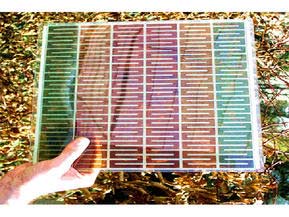Solar-powered batteries have a chequered history in terms of delivering very little of what their developers have hoped for over the years. But a new drive to perfect an old solar technology looks like improving their reputation no end.
Dye-sensitised solar cells (DSSc) are not new - they first appeared in 1991 - but the imminent expiry of many patents covering the technology in 2008 is prompting manufacturers to bring 21st-century research methods to bear on their development
Efficiency increases
Without going into the finer details, a DSSc contains a photosensitive dye that emits electrons when sunlight strikes it. Transparent polymers within the device siphon these off in the form of newly generated electricity.
Foremost among the new wave is a DSSc from Japan's Toin University of Yokohama that takes the form of a flexible A4 sheet. Although the cells have a low solar conversion efficiency of just 6 per cent (standard solar cells start at around 15 per cent), they have two advantages over their silicon-based counterparts.
Cheaper to make
Firstly, they can simply be printed - silicon cells need to be produced in a vacuum - which makes for extremely low manufacturing costs. Secondly, the fact that a DSSc can be made as flexible as the 0.4mm-thick Toin device allows device makers to stick one, for example, on the lid of a laptop PC or to create cells that can be rolled and folded for storage.
Toin's commercial partners currently have production facilities in Japan that can make 10 megawatts worth of DSScs a month, and have a view to commercialising cells for powering phones and other mobile devices from next February.

